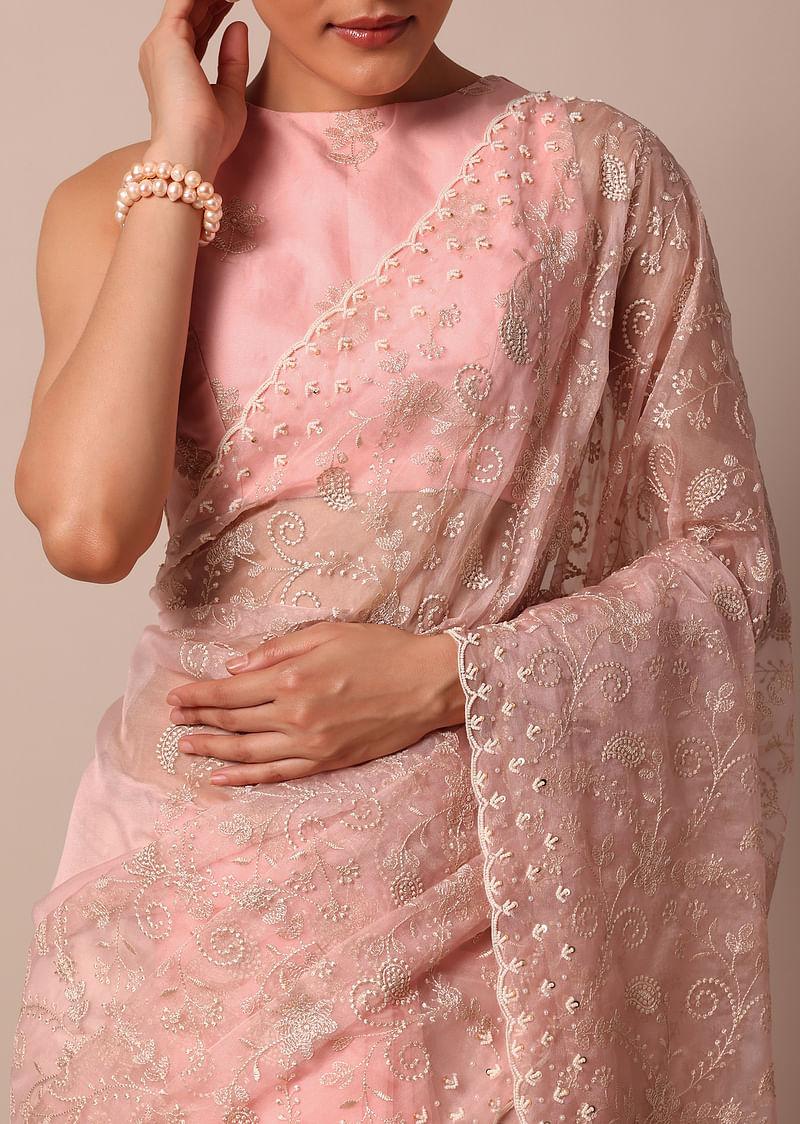From Zardosi to Kantha: Discovering the Art of Embroidery Designs in India
Explore India's diverse embroidery styles to craft a timeless bridal trousseau full of heritage.


Designer (L-R): Kalki Fashion, Mystic Loom, House of Tanvi
Indian diversity goes far beyond our states and weddings—it’s woven into the very fabric of our attire. The intricate embroidery designs from every corner of the country reflect rich regional heritage. From the delicate Kashmiri needlework in the North to the vibrant mirror and Banjara styles of the West and the distinct Toda embroidery of the South, each style carries the story of its region's heritage.
Are you wondering what to pack for your bridal trousseau? Make it a timeless collection featuring exquisite embroidery designs that will be passed down for generations. Each piece will symbolise love, a connection between your maiden home and the new life you're about to build. Let’s explore the ten most popular types of embroidery to style up your trousseau with timeless elegance.
In this article:
- Chikankari Embroidery
- Zardosi Embroidery
- Aari Work Embroidery
- Gota Patti Embroidery
- Phulkari Embroidery
- Mirror Work Embroidery
- Kashmiri Embroidery
- Toda Embroidery
- Kantha Stitch Embroidery
- Banjara Embroidery
Chikankari Embroidery

Origin and History: This exquisite embroidery style hails from Lucknow, Nawabs. Chikankari gained prominence in the 16th century under the patronage of Mughal empress Nur Jahan, and it flourished further with Mughal support.
How to Identify Chikankari Embroidery: Traditionally, Chikankari was a form of whitework embroidery featuring white threads on fine muslin. Today, it incorporates colourful cotton and silk threads, beads, and sequins. Its intricate patterns, influenced by Persian and Turkish styles, are created using chain stitch, back stitch, and hemstitch.
Best Uses for Bridal Trousseau: Chikankari embroidery designs bring a timeless charm to your bridal trousseau. They’re perfect for wedding sarees, Anarkalis, kurtis, and blouse embroidery designs, adding a touch of sophisticated elegance to your ensemble.
Zardosi Embroidery

Origin and History: Zardosi embroidery, which translates to "gold embroidery," originated in Persia and was initially worn by the Mughal royalty. This art form flourished during the Mughal era in India, becoming a symbol of opulence and grandeur.
How to Identify Zardosi Embroidery: Initially using gold and silver wires with precious stones, Zardosi embroidery designs now feature cotton yarn wrapped in metallic threads. The intricate patterns often include motifs like flowers, leaves, and paisleys, giving fabrics a rich, ornate appearance.
Best Uses for Bridal Trousseau: Zardosi hand embroidery designs add sartorial elegance to bridal lehengas, sarees, and blouses, making it a cherished legacy piece passed down through generations.
Aari Work Embroidery

Designer: Sureena Chowdhri
Origin and History: In the 12th century, aari work embroidery was developed by the Mochi (cobbler) community in Gujarat and Uttar Pradesh, who used aari needles to embellish footwear. Under Mughal patronage, it evolved into intricate embroidery on silk and cotton fabrics.
How to Identify Aari Work Embroidery: Known for its chain stitch loops, it uses zari, silk, or cotton threads and is often embellished with sequins and beads. Influenced by Persian motifs, it features vibrant colours and intricate details, making it one of the most elaborate hand embroidery designs.
Best Uses for Bridal Trousseau: Aari work embroidery designs enhance sarees, kurtis, and blouses, making them a treasured part of your bridal trousseau.
Gota Patti Embroidery

Origin and History: Gota Patti, also known as Aari Tari or Lappe ka Kaam, is a traditional Indian craft from Rajasthan. Dating back to the 3rd century, it was later embraced by Rajputs and Mughal royalty, symbolising luxury and grandeur.
How to Identify Gota Patti Embroidery: This embroidery features gold and copper fibres, which are stitched onto fabric or applied using the applique technique. It showcases intricate patterns with motifs like leaves, elephants, and horses, often enhanced with zari or zardozi work.
Best Uses for Bridal Trousseau: Gota Patti embroidery designs add an opulent touch to sarees, ghagras and dupattas. They also make fabulous embroidery designs for suits, Kurtis, and embroidery bridal blouse designs—simply a must-have for your bridal wardrobe!
Phulkari Embroidery

Origin and History: Phulkari embroidery, which originated in the Punjab region, is believed by some to be an adaptation of the Persian Gulkari embroidery designs. While its origins are debated, the floral design technique remains at the heart of Punjabi embroidery.
How to identify Phulkari embroidery: Phulkari is recognised for its bright flower motifs. It is done using a backstitch with vibrant, colourful floss silk threads. The bold and intricate embroidery designs add a unique charm to any fabric.
Best Uses for Bridal Trousseau: A must-have for Punjabi brides, Phulkari dupattas brighten ethnic wear like sarees and lehengas, adding a radiant touch to your wedding wardrobe.
Mirror Work Embroidery

Origin and History: Mirrorwork embroidery was introduced to India by Iranian travellers during the Mughal period. Today, it thrives in Kutch and Rajasthan. Rooted in the Islamic belief that mirrors trap evil, this tradition was embraced by Hindu and Jain cultures, who used mirror torans for protection.
How to Identify Mirror Work Embroidery: Known as Sheesha or Abhala Bharat, this technique uses cross-stitch to encircle mirrors and attach them to the fabric. In various geometric shapes like circles, squares, and triangles, the mirrors are usually sewn onto monochromatic cloth to create a shimmering effect.
Best Uses for Bridal Trousseau: Mirror work adds brilliance to your saree embroidery designs, blouse embroidery designs, ghagras, dupattas, bags, and even jhumkas, making them a dazzling choice for your bridal trousseau.
Kashmiri Embroidery

Origin and History: Kashmiri embroidery, known as Kashidakari, flourished in the 15th century under Sultan Zain-ul-Abidin and peaked during the Mughal era. Rooted in the picturesque valleys of Kashmir, it combines Persian and Mughal influences passed down through generations.
How to Identify Kashmiri Embroidery: Known for intricate floral motifs and nature-inspired patterns like paisleys, Kashmiri embroidery designs stand out with fine needlework and vibrant threads. They’re often crafted on silk, cotton, and wool using chain stitches.
Best Uses for Bridal Trousseau: A Kashmiri embroidered shawl, lehenga, saree, or even a simple blouse or dupatta can effortlessly elevate your bridal look, adding a touch of luxury to your ensemble.
Toda Embroidery

Image Credits: Pinterest
Origin and History: Toda embroidery is an age-old craft practised by the Toda people of Tamil Nadu. Passed down through many generations, this intricate art is deeply woven into the community's cultural identity, showcasing its rich heritage.
How to Identify Toda Embroidery: Toda embroidery is characterised by bold geometric patterns and vibrant reds and blacks, almost like computer embroidery designs. The stitches are large and loose, creating a unique textured effect. Motifs like spirals, diamonds, and crosses are common, symbolising the tribe’s bond with nature.
Best Uses for Bridal Trousseau: Toda-inspired embroidery designs bring ethnic charm to modern bridal trousseau. Incorporate them into your wedding accessories, such as shawls, belts, clutches, and jewellery, for a unique touch of heritage. They could also be one of the stylish and simple embroidery designs for your blouses.
Kantha Stitch Embroidery

Designer: Mulberry Trails
Origin and History: Kantha stitch embroidery is an ancient craft from Bengal and Odisha. It was originally practised on old sarees and dhotis. This technique, involving simple running stitches, was traditionally used to repurpose fabric by stitching multiple layers together, often creating quilts or bedcovers.
How to Identify Kantha Stitch Embroidery: Recognised for its layered fabric and fine-running stitches, Kantha often features motifs of birds, animals, and flower embroidery designs. The stitching gives the fabric a slightly wrinkled, textured effect, with designs typically sewn in white or vibrant-coloured cotton threads.
Best Uses for Bridal Trousseau: Kantha hand embroidery designs add rustic charm to bridal wear. For a timeless touch, incorporate them as simple embroidery designs for suits, sarees, dupattas, blouses, and even home decor.
Banjara Embroidery

Designer: House of Tanvi
Origin and History: Banjara embroidery is a lively and intricate craft practised by the nomadic Banjara tribes across India. Rooted in their vibrant, travelling lifestyle, this art form adorns their clothing and accessories, reflecting their rich cultural heritage.
How to identify Banjara embroidery: Known for its bright, bold colours and geometric patterns, Banjara embroidery designs combine patchwork, mirror work, and loose, textured stitches. Common motifs include flowers, animals, and abstract shapes, often stitched onto colourful fabrics.
Best Uses for Bridal Trousseau: Banjara embroidery brings a bohemian flair to a bridal trousseau. Incorporate it into ghagras, sarees, or blouses, and add a touch of eclectic charm to accessories like clutches, belts, and jewellery.
Embroidery designs can transform your bridal look from beautiful to breathtaking. Don’t be afraid to mix things up—choose Zardosi and Aari work for that luxe feel, Chikankari for classic elegance, and Banjara for a fun, bohemian vibe. Curate a trousseau as unique as you are—bold, beautiful, and timeless!
More Bridal Fashion Inspiration here:
3. How to Drape Your Lehenga Dupatta?











